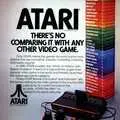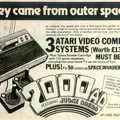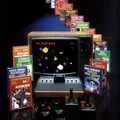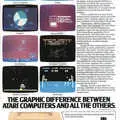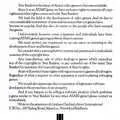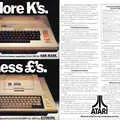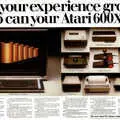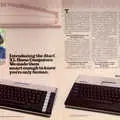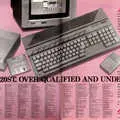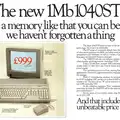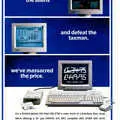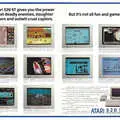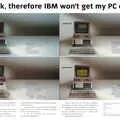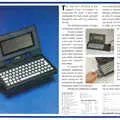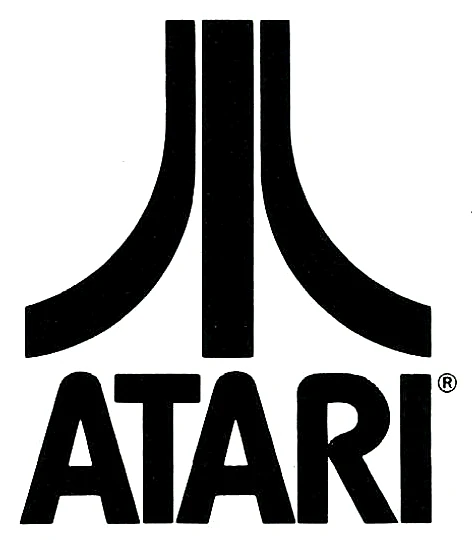
Atari Advert - June 1987
From Your Computer
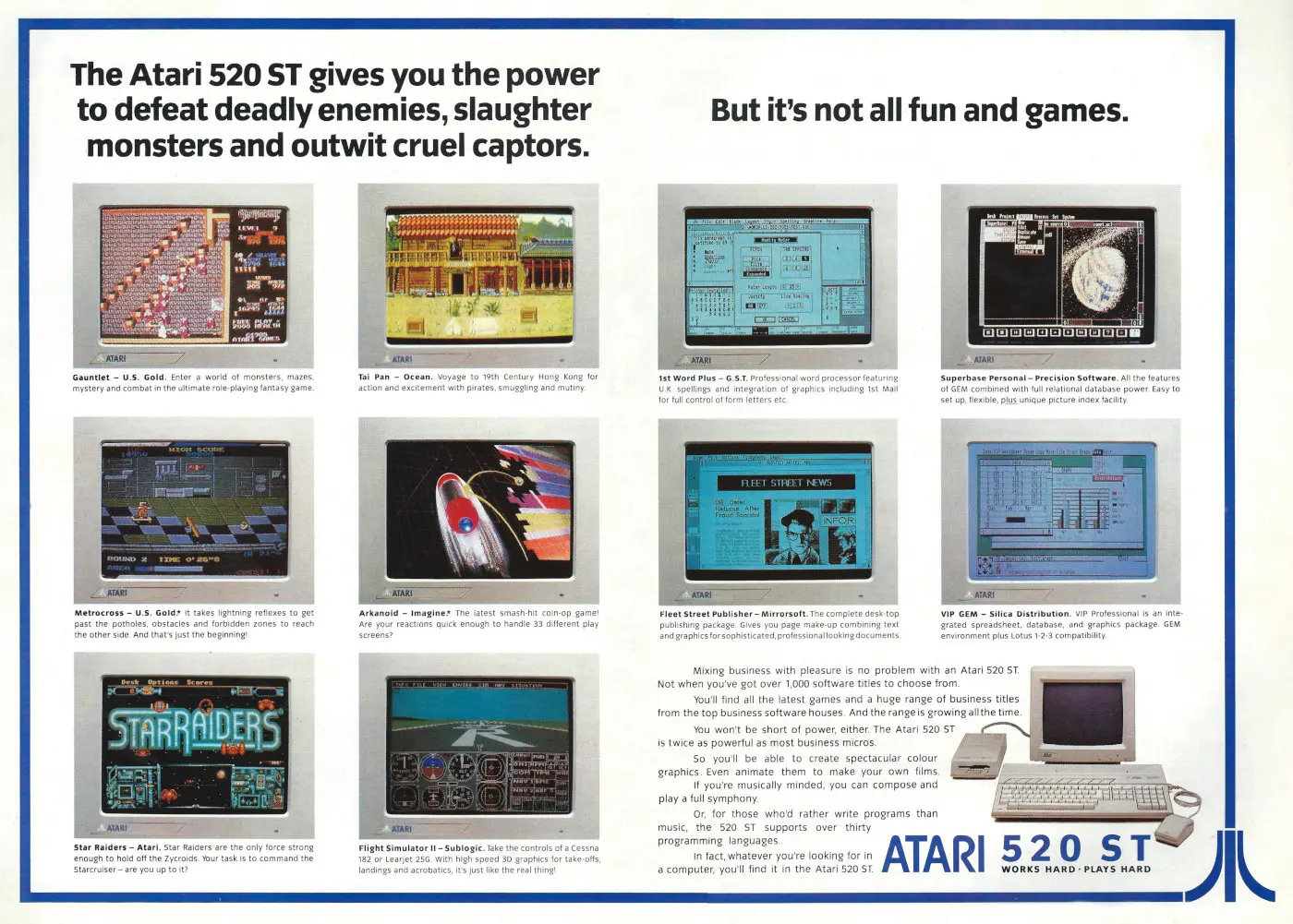
Atari 520 ST: It's not all fun and games
Here's another advert for Atari's 520 ST - for Sixteen/Thirtytwo - the Motorola 68000-based machine with 512K RAM and which became popular amongst musicians, thanks to its built-in MIDI connectors.
There's also clearly some attempt to position it not just as a home/games/music system, with some business stuff on display too.
It's over two years since the ST had been launched, and it was becoming apparent that Atari had not really released anything new for a while, apart from modifications of the same basic "Jacintosh".
As one observer at the 1987 Atari show pointed out "There is a limit to the number of times Jack Tramiel can pull a rabbit out of a hat, before people notice it's always the same rabbit".
This lack of new product was fueling rumours that Atari's attention was elsewhere, and that it was actually invoved with Inmos's Transputer in some way.
The Transputer - a portmanteau word combining Transistor and Computer - was a radical new parallel-processor architecture developed by Inmos of the UK, a company which had been set up in 1978 "to counter the drift of semiconductor technology away from the UK"[1]
It was also noted that Atari had no vertical integration - no chip fabrication facilities, no disk manufacturing and even no real US presence.
As Guy Kewney wrote it was "All front and no substance; it is a cash mountain made out of paper money, waiting to blow away in the first real wind".
Adding to that was the realisation that Motorola's 68000 processors were nearing the end of their life, with the 68030 being the last of the line.
This left Atari with nowhere to go, so the news that Atari was in talks with a designer of Transputer-based machines added fuel to the fire[2].
There were also rumours that Atari planned to set up a Sinclair-style research lab in the UK, specialising in advanced software research.
Sinclair's Metalab had been set up back in 1984 to research wafer-scale silicon, which the company hoped to use as a form of solid-state storage, as well as possibly to host an entire raft of interconnected Transputers on a single wafer of silicon.
Whilst Atari was also thought to be looking at RISC technology, what with the rumours of its talks with Transputer companies, its immediate software-based focus was somewhat more pragmatic and short term, and the company was thought to be negotiating with UK programming teams to staff its facility.
The location was reportedly down to the UK's reputation as a source of programming expertise, with Atari's Jack Tramiel saying during a visit to the Atari show in late Spring that "[he could] smell the success here".
It was thought that an eventual new West German centre would concentrate on harware, whilst manufacturing itself would return home to the US from its current domicile in Taiwan[3].
Before Atari got round to releasing a Transputer machine, Tim Moore of Kuma launched K-Max, the first Transputer development system for the Atari ST, in May 1987.
The box, which connected to the ST over a custom 20mbps serial link, offered the Inmos T414 processor, which was sadly not the version of the Transputer which included floating-point maths and was said to be as fast as a DEC Vax 8650 supermini.
Other drawbacks were that the language required to make the best use of the transputer - Inmos's own Occam, developed by David May with the assistance of Professor Tony Hoare of the Programming Research Group at Oxford University, and named after the 14th-Century philosopher famous for his razor[4] - wasn't even available yet.
Also, the module wasn't implemented as a co-processor for the ST's own 68000, which meant that unlike other second processors, like Acorn's 6502 second CPU, you couldn't make the base machine super-fast[5].
Meanwhile, development work for Atari's own Transputer machine was being carried out by British company Perihelion - which included Dr. Tim King, formerly of Metacomco and the author of rival Commodore's AmigaDOS[6] - with a £100,000 grant from the UK's Department of Trade and Industry provided to help develop the machine's operating system[7].
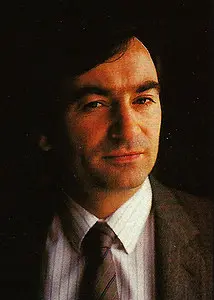
Bob Gleadow, MD of Atari UK, © Popular Computing Weekly, June 1989In order to fill in the gap between machines, Atari planned to release an Intel 286-based IBM compatible at Las Vegas Comdex in November 1987 with a follow-up 386 machine to be launched during the Spring 1988 Hanover Fair, alongside a Unix add-on for the Atari ST[8].
The company had already released its £400 entry-level 8086 Atari PC in June 1987, which had been previewed at the Atari show held in London during April, but ended up skipping the originally-planned 80286 micro.
Atari's chairman, Jack Tramiel, had flown over specially to make an appearance at the show and explained the company's move in to the IBM-compatible market, saying
"We aim to cover the total spectrum of business and we are now fully equipped to do this. People want an IBM clone because it's what they have in their office. If they want to buy them we are going to make them. It's not something I'm very proud of".
Tramiel also glowingly praised Atari UK's head - and former Commodore UK general manager - Bob Gleadow's role in the whole Atari resurrection, and according to Your Computer a "justifiable air of self-congratulation could be detected".
Perhaps there was some merit given the 81.8% increase in sales from 1985 to 1986[9], and the fact that Tramiel had taken the company public and had raised an additional $30 million in capital for expansion.
As Guy Kewney wrote: "no-one in the financial community is willing to bet against this durable man and his company"[10].
The two models of Atari's PC had first made an appearance at the Spring '87 Hanover show, on a stand very much overwhelmed with the new 1040STF and the Mega STs.
The company didn't seem quite sure what the specification was, as in the US the difference between the two available models was that while both had 512K RAM, EGA graphics, one 5¼" disk drive and MS-DOS 3.2, only one came with a monitor, whereas in the UK Bob Gleadow was talking about selling both with the monitor but only one with EGA.
Tramiel didn't seem too bothered, saying that "It's perfectly possible to do the clone differently. If Gleadow wants the EGA distinction, then he can have it".
He continued with his almost-slating of his own company's IBM clone, saying
"The IBM range is old-fashioned and inferior technologically to the STs. But if people want to buy our PC compatible, they can. However, we will tell them they're buying the wrong machine [and] that they should be buying an ST. Atari has done a fairly good job with brand new-technology and not copying what is old. We've sold well without a PC clone, but we will produce machines which the public wants, and there is a demand for low-cost PC clones"[11].
Meanwhile, UK release dates for the Mega STs which also featured at Hanover were revealed.
The machines were essentially bigger-memoried STs but finally came with a blitter built in - the "bit image manipulator" chip devoted to moving around large chunks of memory incredibly fast and which helped make the rival Amiga seem effortlessly powerful.
There was also a maths co-processor and an "open bus" for expansion. They were scheduled to appear in June, priced between £700 and £1,200, or around £2,560 and £4,400 in 2025[12].
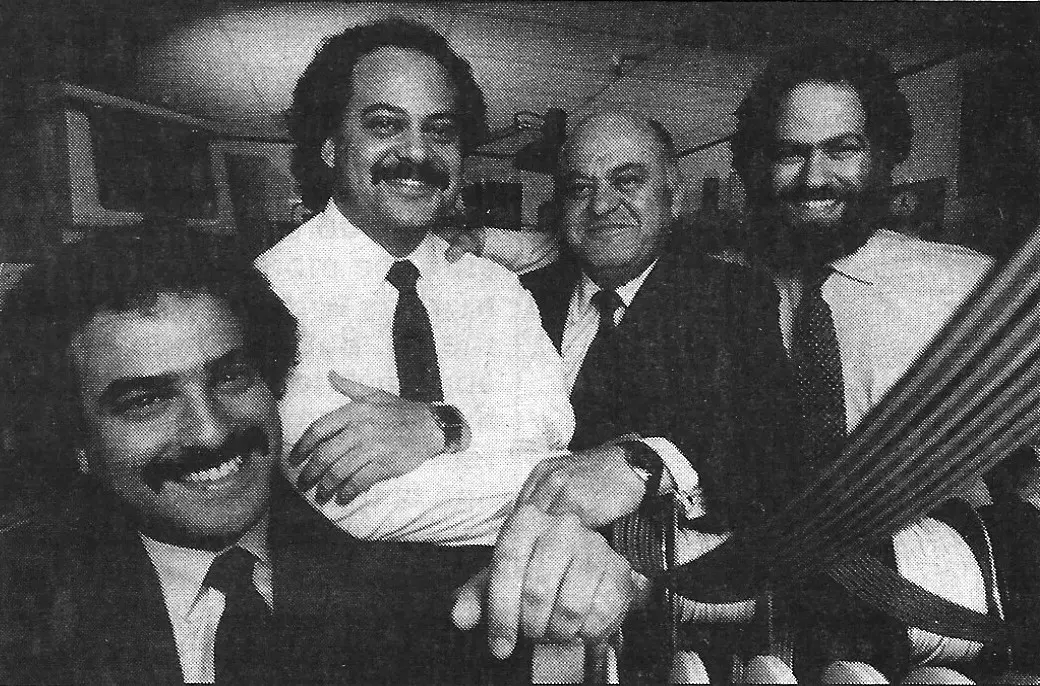
The Tramiel family: Gary, Sam, Jack and Leonard, © Personal Computer World July 1987The same blitter that was shipping with the Mega STs was also being made available as an upgrade to all existsing Atari ST owners, although president Sam Tramiel was suggesting that these wouldn't be available until July.
The days of soldering-iron action had clearly long passed, as Tramiel (Sam) was quick to point out that "we certainly won't be offering it as a DIY job", and that it was an authorised-dealer-only upgrade[13].
Atari was also unexpectedly mindful of its developer community, as it shipped the ability to turn off the blitter in software or even via the machine's desktop.
This was because some software houses had been bypassing Atari's own graphics routines in order to run their own faster graphics machine code, however he presence of the blitter would cause these sorts of unofficial "hacks" to crash the application using them[14].
That compared favourably to companies like Sinclair, which when a hardware upgrade to its Spectrum rendered some commercial software inoperable, essentially told the developers "tough luck".
In a seemingly never-ending stream of news from Atari, the company also announced at the Hanover show that it had made record profits in the last quarter of 1986, posting just over $258 million in revenue, or around £172 million (£630 million in 2025), over $100 million more than in 1985, with a profit of $25 million compared to a loss in 1985 of $14 million - itself massively improved over the near half-billion the company lost in the last year of its Time Warner ownership.
Jack Tramiel also made an interesting admission, that
"it [was] the first time since running a company that I've had money in the bank. With [Commodore] we borrowed. Now we are debt-free and have $70 million in the bank".
There was some recognition of Atari's changing fortunes from WH Smith, although it was mixed with a denial that the high-street newsagent was taking on Atari's ST and 65XE games console, following claims from Atari's marketing manager Paul Welch that it would.
Or as WH Smith hardware buyer John Rowland said, "well he would, wouldn't he?". Rowland continued
"We haven't signed anything yet, nor have we made any concrete moves towards stocking Atari's machines, but they do seem to be coming back into the mass market, which is good news"[15].
Of course, as is the way of things, a denial is swiftly followed by an admission, as Rowland confirmed only a week later that Smiths was "ready to try out the machine" in some of its 250 computer departments, saying "We think it's a terrific machine, but we think its price-point is a bit high. But it's what we play our games on here".
After the 520STFM model had been launched in September 1986, ten weeks late and 16 weeks after the launch of its cousins, the 520STM and 1040STF[16], it got a sales boost from Smiths when the company announced that it was going to give away £200 of software with every machine sold - a discount which followed not long after Atari had announced its own £100 price cut.
WH Smith's computer buyer Ian Laurie said that the company though that "the Atari STFM is one of the most advanced computers in the home market" before adding that "this excellent software package shows just what the computer is capable of and at no extra cost to the consumer"[17].
1987 was definitely the year when Jack Tramiel's golden touch was proved to have returned, as sales of the Atari ST enabled Atari to stage "a phenomenal financial recovery" from its pre-Tramiel nadir in 1983 when it made a loss of $425 million in the first three quarters of the year[18].
Half-year sales at the end of 1987 showed a 132% increase in profits, which were based on net income of £17.5 million, up from £7.5 million for the same period the year before.
It was thought that this would confirm Bob Gleadow's hope of 100,000 sales in the UK during the Christmas 1987 period, which would make the ST a truly mass-market machine - something very dear to Tramiel's famous "for the masses, not the classes" sales ethic.
However, although Atari's chief financial officer Greg Pratt was reporting shortages in every Atari subsidiary, it was once again the UK that seemed to be the major market, with Atari yet to get to grips with the US whilst facing strong competition in Germany.
At least this time Atari wasn't faced with the prospect of reducing its prices to make its machines sell, as the price of its ST was already considered competitive.
Instead, it was using its profits to offer more power to its existing range, as well as maybe offer the rumoured CD-ROM and Transputer.
Atari was even considering aquiring a semiconductor factory to produce transputer chips, which would give it head-start chip technology to see it through to the 1990s[19].
The reported shortages of the ST turned out to be significant as they had left dealers without stock throughout August and September and, according to Popular Computing Weekly were leaving "many potential customers in a state of desperation".
They were addressed in October, as the company admitted that it might have made insufficient forecasts for ST sales earlier in the year.
A spokesman stated that "we have made extraordinary moves to get a quantity of STs airlifted from Taiwan", before suggesting that bereft customers should visit a large branch of WH Smith if they were still looking for an ST.
Meanwhile, Atari's CD-ROM unit was announced with a price of £399 (£1,460) and the name "CBAR 500", with the company confirming that it would reach the UK in November, albeit in "very small quantities"[20].
This compared very favourably with CD-ROM systems aimed at business, which even a year later were still in the £630 (£2,210) range, at least for Hitachi's 1503 CD unit, even after a 16% price cut[21].
Even though it no longer had to, Atari was still planning to "take the micro market by the scruff of the neck" during the Christmas 1987 period, by reducing the price of its 520STFM (which should have stood for Shut the F**k up, Mofo, but actually meant Sixteen/Thirty-two, Floppy, Monitor) by an extra £100, which made it only £50 more than Amstrad's decidedly 8-bit Spectrum Plus 3, as well as giving arch-rival Commodore's £500 Amiga something to worry about.
The reduced-price STFM, if purchased from WH Smith, even came with the previously-announced £200 offer bundle of six actually-decent games - a rare enough event when normally only well-worn "tat" would be given away in such a fashion.
Meanwhile, the older-style STs were being offered with a bundled disk drive and monitor for only £450, in an attempt to clear out remaining stocks[22].
There were also rumours that the company might also ressurect its 7800 games console, which Your Computer thought must have been lying in a broom cupboard since 1983, before deciding instead to ship the "unimpressive" 65XE - a version of the Atari 400 without a keyboard.
The XE had been intended for Europe, but ended up in the US, so it was wondered whether the 7800 might make its way to the UK[23].
The aggressive marketing of the ST seemed to bite Atari in the bum during the Christmas run up as the company struggled with ongoing shortages and disgruntled dealers, some of whom were yet to receive a single machine.
It was thought that there was a worldwide shortage of some 200,000 Atari STs, with 20,000 AWOL in the UK alone[24].
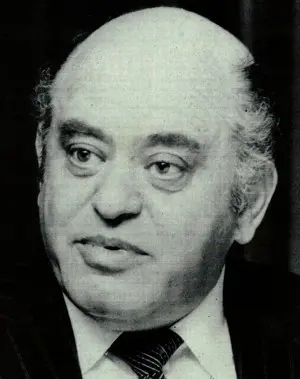
Atari's CEO, Jack Tramiel, © Popular Computing Weekly October 1987As Atari rolled in to 1988 it seemed to be in a good position, at least in terms of how it was covering pretty much every market it could think of.
With Jack Tramiel's "avowed intention to get more involved in the software distribution field" and the rumoured resurrection of its dormant Atarisoft mail-order software business, the CBAR 500 CD-ROM, 65XE games machine, SML 104 laser printer - a potential competitor to Apple's dominance of the desktop-publishing industry, the pointless but politically-expedient Atari PC, the $70 million purchase of the Federated chain of electrical retail stores in the US, Transputer-based machines and sales of the ST approaching 500,000, the company was everywhere.
This ubiquity led Popular Computing Weekly to suggest that Atari was losing direction, giving the example of the 65XE - a games console launched at a time when the ST itself seemed to be moving away from the business market towards games.
The Atari Transputer workstation lives
When it finally arrived in the early spring of 1988, Atari's Transputer workstation project came in two flavours - a plug-in for the Atari ST, and a dedicated stand-alone machine.
The stand-alone machine was essentially an entire Atari ST plus the Transputer itself, whilst both models were said to be capable of 15 MIPS with a 1-million-pixel display running at 18 frames per second at up to 16 million colours - mind-boggling specifications at the time.
It was to be based on the Inmos T800 Transputer, a RISC chip capable of massively-parallel operation and developed at a cost of millions, thanks to UK tax-payer funding[25].
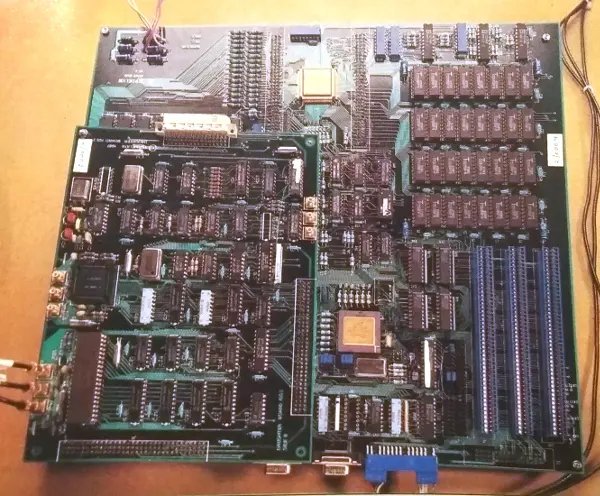
Early version of Atari's Abaq Transputer motherboard, © Personal Computer World February 1988The origin of Atari's Transputer machine, which was known early on as Abaq - the Hebrew word for "sand" - until Jack Tramiel discovered another company had named its machine in the same way[26], started at Perihelion in the UK.
Perihelion's directors Jack Lang and Tim King, the latter formerly of MetaComCo and the author of arch-rival Commodore's AmigaDOS, had decided to design and build a graphics workstation based on the idea of a modular, distributed, processing system which could interconnect to any other workstations also running Transputers.
Atari leaped at the chance to get involved by supplying an I/O front-end in the shape of the 68000 processor it was already using, plus some marketing backup, and within four months the two companies had produced a prototype shown at Comdex Fall '87, where it was originally known as the Atari Workstation Transputer ATW800.
As well as the T800 Transputer, the most interesting part of the Abaq was its custom video chip, known as Charity, which was designed by Richard Miller at Perihelion Hardware.
Miller had previously designed a gate array - the newer form of hardware-programmable logic chips, similar in function to the ULAs popular a few years before and related to modern FPGAs - for Clive Sinclair's Z88 portable[27].
As well as supporting the sorts of video resolutions which at the time required specialist monitors - such as 1280 x 960 pixels - Charity acted as a full-colour blitter, capable of moving around video memory at a rate of up to 16 million pixels per second, and could plot characters on the screen at a rate of 64 million pixels per second[28].
Rounding out the Abaq package was its operating system, Helios, produced by Perihelion Software as a sort-of Unix-like OS, but which could support multiple processors, which regular Unix couldn't do at the time.
Helios did, however, make use of the Unix windowing system, X-Windows, for its graphical display.
The Wizards of Transputerdom
Response to Helios, based upon developer feedback after the first 50 Abaq machines had been built and shipped in March 1988, was one of "confusion", which Guy Kewney of Personal Computer World took to mean that it would be several more months before there was a likelihood of actually seeing any new software for the machine.
However, other Transputer suppliers were acting to push prices down in anticipation regardless.
This included Kuma's K-Max board which was now - at £700, or £2,460 in 2025 - around half the price it was when it launched the previous year, and Transputer developer Inmos itself, which had announced a development board family it was calling Trams (Transputer Modules).
Elsewhere, Transputers really did seem to be picking up steam, as there were several exhibits featuring the wonder-chip at the Wembley Micro Development Systems show, including a hugely-powerful 32-transputer module built for Sun workstations, a four-player flight simulator using 64 Transputers and Cambridge RISC Machines' Amstrad front-ended Helios-running system.
The word was that Helios was "more flaky than usable" but was better than nothing[29].
Whilst Transputers in general seemed to be going well, Atari's own Transputer Workstation/Abaq seemed to be the victim of Atari's legendary political infighting, as you could get the TPW in the UK and maybe Europe, but not the US, whilst you could only get Atari's Unix box in the US and maybe Europe, but not the UK.
It was the same with Atari's CD-ROM players, which could be had in the US or Germany, but also not the UK.
Only the ST seemed free of regional restrictions, although Personal Computer World reckoned that this would only last for as long as it took for somebody in Atari to discover that particular anomaly.
The infighting was perhaps best revealed by a squabble over a complete reference manual for the ST, which a US team had been working on for some four years.
Sometime in 1988, Jack Tramiel decided that "enough was enough" and gave the project over to Atari UK.
Unfortunately, Leonard Tramiel in California decided that the US should remain in charge of the project, and refused to give the UK the information it needed to finish off the manual[30].
---

Tim King of Perihelion, developers of Helios, © Personal Computer World September 1988Helios might have been the only operating system kicking around for the Transputer, but there was a choice in development languages.
As well as the "official" choice - Occam - there was also TOPS, which came about as a way of overcomming the complexities of writing software for multiple Transputers.
TOPS had been started by Transputer User Group founder Howard Oakley, as well as Microway and Lattice Logic - the two companies pitching in when they found themselves competing against Inmos itself.
Whilst Occam was free, it would only create code that ran on a single Transputer - anything more required the use of a bit of software called the Configurator, which was only available embedded in the £1,500 (£5,270) Transputer Development System.
Microway already had a "gentelman's agreement" with Inmos which allowed it to supply a simple version of the configurator called the Monoputer, which was a copy of the Inmos development board, the B00.
However, Inmos had realised that unbundling the configurator would mean that nobody was going to buy its full-on development system, and resistance to do so meant that there was an opening for a new operating system to provide an alternative.
As Nik Spicer of Microway summed it up: "One of the important things about Transputers at the moment is that the facilities available are not terribly friendly.
Occam is OK for one Transputer, because you can run code like any other computer.
But if you start using multiple chips, it gets very convoluted".
By the beginning of 1988, Microway was demonstrating both its Quadputer four-Transputer board, as well as the Transputer-based Videoputer.
The latter was seen demonstrated by PCW's Kewney, who said of it that "it may not be the smoothest board in the world of Transputers, [but] it is one of the few that actually exist"[31].
Baggage
The Abaq was relatively expensive, with Bob Gleadow suggesting that the entry-level price would be about £3,000 with the specialist monitor required for its high-resolution video adding perhaps another £2,000, giving a combined total of some £17,500 in 2025 money.
Not only that, but as Atari's UK technical manager Les Player had to admit, it was hard work persuading the world that the Abaq wasn't simply a super-powerful Atari ST, in the same way as Commodore had had something of hard time persuading people that the Amiga wasn't simply a very fast games machine.
It was even suggested that Atari might be better off spinning its Transputer models out into a separate entity in order to market them away from the baggage of its own history[32].
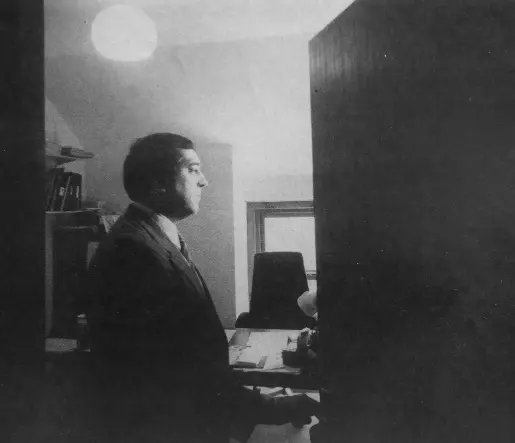
An enigmatic Tim King, © Personal Computer World September 1988Also struggling to shake off various preconceptions or outright misundertstanding was Perihelion's Tim King, who on announcing its operating system for the Abaq had been lauded as "the prince of British programmers", at least according to Personal Computer World.
However, it was soon clear during the first Helios developers' conference, held in Bath, that a lot of people were getting the wrong idea about what Helios could do - in particular that whilst it could ensure that a program written specifically for a Transputer would run on as many Transputers as were available, it couldn't as it turned out somehow magically make any old bog-standard C program suddenly multi-processor-capable.
Perihelion also had a baggage issue with Atari, in that because Atari had put up some money for the initial development of Helios it must therefore somehow own Perihelion.
In reality, Atari only had a licence for Helios, but denying any Atari ownership lead instead to accusations that Perihelion must therefore be owned by Japanese computer company Meiko.
Meiko, which made large-scale computers using Transputers, had also put some money into Helios licencing and had also helped out in its development.
All of this meant that King was having to constantly persuade potential hardware companies interested in the Helios OS that it was independent and that they wouldn't actually be buying it from a rival hardware company[33].
Sadly, despite the ahead-of-its-time specifications, it was thought only around 350 Abaq machines were ever produced[34].
Hedging bets with Unix
The Abaq wasn't the only thing that Perihelion was working on, as by the spring of 1988 it was also close to the final stages of prototyping an ST-based laptop, said to be available by Christmas of that year.
Designed in Perihelion's Cambridge offices, the machine - codenamed Stacey - was essentially a straight-up Atari ST crammed into a portable box, although it broke from the convention of its bigger sibling by going for a trackball rather than a mouse.
Sam Tramiel reckoned that "you might be lucky and find somebody wearing a tight skirt sitting next to you on a plane", but otherwise there wouldn't normally be any suitable surfaces around on which to drive a conventional mouse.
Whilst Stacey's 68000 CPU was fairly power-efficient, being a CMOS design, the usual ST support chips and electronics were less so.
To counteract this, Perihelion had also designed a large dedicated gate array to replace them all in the new laptop.
Final details though - amount of memory and so on - would however depend on what was actually available - and what was cheapest - when the machine was launched to the press around July.
Meanwhile, Atari had a rather more exotic machine up its sleeve, in the shape of a Unix ST machine, describe by Atari owner Jack Tramiel as "the machine which will bring Unix to the consumer - well, to the personal user".
Tramiel senior was working on the assumption that there was a group of potential buyers which wanted to run some sort of multi-user Unix accounting software but which wasn't prepared to pay the usual exhorbitant prices for Unix systems - a market segment that Guy Kewney of Personal Computer World concurred was a Thing.
The Atari Unix ST, running the Unisoft version of AT&T's System V Unix, was to be based on Motorola's 68030 chip and would be available for less than $5,000.
It was also expected to be based on the VME bus - a standard based largely on the 68000 CPU itself[35], but also said by Atari's research-and-development vice president Shiraz Shivji to be much like IBM's new Micro-Channel Architecture.
Personal Computer World's Kewney was somewhat sceptical, questioning whether the ordinary "untrained user without the support of a programming department [could] learn to use and love Unix".
Whilst conceding that Unix was indeed more powerful than MS-DOS and even Microsoft's new OS/2, he reckoned that most users already found DOS more complicated than they would like.
He concluded "I'm not going to stick my neck out very far, but seriously, I do doubt that Unix is going to become a fad"[36].
Date created: 08 January 2024
Last updated: 11 December 2024
Hint: use left and right cursor keys to navigate between adverts.
Sources
Text and otherwise-uncredited photos © nosher.net 2025. Dollar/GBP conversions, where used, assume $1.50 to £1. "Now" prices are calculated dynamically using average RPI per year.


